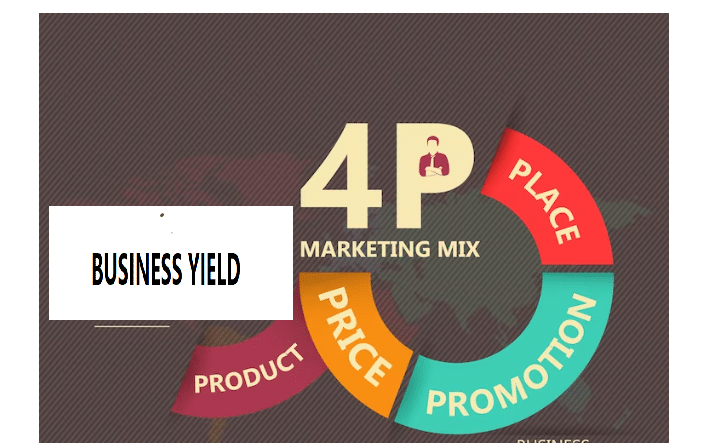The four Ps are a marketing mix consisting of product, price, place, and promotion used by businesses to create effective marketing plans and strategies for their target audience. These elements are the most common and foundational to a successful marketing plan.
You can find a detailed description of the four PS as well as more information about their history and purpose in this article.
Definition Of The Marketing Mix
The marketing mix refers to the four main components of a marketing strategy—product, price, place, and promotion—which are also referred to as the “four PS of marketing.” The following four elements of the marketing mix can help a company increase the likelihood that a product will be noticed and purchased by customers.
Furthermore, the four Ps are crucial considerations in marketing a product or service. These factors include consumer wants, product or service performance, perceived value, competition, and customer interaction.
Note that:
- The 4 Ps are the four crucial components of promoting a good or service to the general public.
- Products, prices, locations, and promotions are the four Ps.
- The four-PS idea was introduced in the 1960s. Other Ps, such as people, process, and physical evidence, have been identified as the marketing sector has grown.
History Of The 4 P’s of Marketing
The marketing mix, first introduced in 1960, was formalized by Harvard professor Neil Borden in his 1964 article “The Concept of the Marketing Mix.” Borden’s idea was inspired by James Culliton’s analogy of successful marketers as professional chefs. Additionally, he explains some factors that can alter a marketing mix including consumer motivation, competition, and government regulations.
The 4 Ps Of The Marketing Mix
#1. Product:
Product refers to the goods or services being marketed to the target market. Successful products typically meet a demand-generating, unmet need in the market or offer a novel customer experience. For instance, the Android smartphone satisfied a market need for a straightforward gadget that connected and had the capabilities of a mobile phone and the speed of a computer to satisfy the need for consumers to always connect on the go.
Therefore, you must always keep your target consumers in mind as you work on your product and their needs. When developing a product, the following considerations should be made:
- What do you sell?
- What does your product accomplish?
- Does the product fill a gap in the market or offer a fresh experience?
- Who is the intended market for your product?
- What distinguishes your product from what others have to offer?
#2. Price:
Price is the cost of a product or service, and selecting a price that is accessible to the target market and meets business goals is crucial for product success. High or low prices may discourage customers, while high prices may lead to lower sales. Understanding the target audience and their willingness to pay is essential for determining a successful price.
Therefore, some questions you might ask yourself as you are considering your product’s price include:
- What price ranges do your product’s rivals offer?
- What is the range of prices for your market?
- What cost will your audience not accept?
- What is too cheap?
- Which price fits your target market the best?
#3. Place:
The place is the location where your product is sold and distributed, which is crucial for reaching your target audience. Finding the right place to market and sell your product is essential for connecting with your target audience and achieving success.
Additionally, focusing on sports publications and specialty athletic stores can help you target your efforts and create a tailored marketing mix. Research the physical or digital places where your target audience shops and consumes information to determine the best place for your product.
Therefore, some questions to consider include:
- Where will your product be sold?
- Where do your target market’s customers shop?
- What are the most effective distribution channels to reach your target market?
#4. Promotion:
Promotion is the process of advertising a product or service effectively, ensuring it resonates with the target audience. Traditional methods include word of mouth, print advertisements, and television commercials. In the digital age, additional channels like content marketing, email marketing, and social media marketing can be utilized.
Therefore, as you work on your product promotion, there are a few things to think about:
- When is the perfect time to communicate with your target market?
- Which marketing avenues are most successful with your target market?
- Which advertising strategies are most effective with your target market?
What Are The 7 Ps Of Marketing Mix?
The 4 PS of marketing strategy have now been utilized since the 1960s to support the mix concept. A group of four letters known as “the 4Ps” are:
- Product
- Price
- Place
- Promotion
While the original four Ps remain in place, Booms and Bitner also added three more:
- People
- Process
- Physical evidence
#5. People:
Businesses depend on the people running them, right? You need the right people because they are an integral part of your company’s offering, just like the goods and services you offer. Examples of this include customer service, employee performance, and employee appearance.
As a result, defining who the “appropriate people” are for your business may be challenging, but it should take into account the following three aspects:
- Exceptional service
- Genuine enthusiasm
- Be open to suggestions
#6. Process:
Your goods or services are presented to customers using the process in the marketing mix. Your company’s efficiency can be guaranteed by your sales funnel, distribution network, or other methodical operations. To save money, you’ll also want to ensure that your method is well organized.
Other instances include the sequence in which people complete tasks, the volume of questions that salespeople field, and how performance is tracked and evaluated.
#7. Physical evidence:
Physical proof is essential for the 7 Ps of marketing, including material and intangible elements like product packaging, receipts, and customer service. Intangible physical proof includes a company’s perception in the marketplace.
Additionally, consistent branding across channels impacts customers’ views, making their brand the first thing they think of when they hear a word or phrase. For instance, McDonald’s is a popular example of intangible physical evidence.
What Are The 5 Tools Of The Marketing Mix?
#1. Advertisement:
Advertising is non-personal, mass communication that lacks personal contact. It is a paid, one-way communication and is provided by an identifiable entity or person. It is costly but can be reproduced frequently and has the lowest per-contact cost. Additionally, advertising can be used in audio-visual, print, and outdoor media. It is a widely used and popular marketing tool.
#2. Sales Promotion:
Sales promotion is a marketing activity that stimulates consumer purchasing and dealer effectiveness by involving short-term and non-routine incentives. Additionally, it can be used in various ways, like demonstrations, trade shows, exhibitions, exchange offers, seasonal discounts, free service, gifts, and contests.
Typically, its primary purpose is to induce immediate buying or dealer effectiveness, but excessive use can negatively impact sales and company reputation. Sales promotion consists of short-term incentives and non-routine selling efforts.
#3. Personal Selling:
Personal selling is a highly effective and costly tool for market promotion, involving face-to-face communication and product presentations with potential and actual customers. Additionally, it aims to promote products or increase sales, involves two-way communication, and allows immediate feedback measurement. Personal selling is flexible, has higher per-contact costs, and involves teaching, educating, and assisting people to buy.
#4. Publicity:
Publicity is a traditional form of mass communication that involves promoting an organization’s products or services without being paid for by the organization. It is a non-paid form of market promotion with indirect costs.
Additionally, publicity can be carried out through newspapers, magazines, radio, or television and has high credibility. It can be done at a lower cost than advertising and can be repeated depending on its social significance or news value. Therefore, the frequency of publicity depends on the company’s social significance and the frequency of its coverage.
#5. Public Relations:
Public relations involves maintaining constructive relations with customers, suppliers, and the interested public, including publicity. Additionally, it aims to build a favorable image for an organization and influence attitudes toward various groups, including customers, employees, unions, environmentalists, the government, and local communities. Note that public relations is an extension of publicity.
What Are The 5 Cs Of Marketing?
#1. Company:
The company section focuses on many internal elements involved in marketing and selling your goods and services. Among the essential components are:
- Brand image
- Competitive advantages
- Goals
- Products
#2. Customers:
The customer section provides information about the people who use or interact with your products and services. Considerations for this segment include the following:
- Communication channels
- Customer behavior
- Customer motivation
- Customer perception
- Target audience
#3. Competitors:
The competitor’s section highlights the people and businesses that your company is most similar to in the market. Several elements include:
- Compatibility gap
- Competition Strategies and Tactics
- Competition strengths
- Competition weaknesses
- Emerging competition
- Established competition
#4. Collaborators:
The collaborator’s section focuses on every person or entity involved in the development, production, marketing, or distribution of your goods or services. Categories consist of:
- Content creators
- Distributors
- Investors
- Partnerships
- Service providers
- Suppliers
#5. Climate:
The climate, or “context,” section focuses on outside variables that are out of your control as a business. A few examples are:
- Economic trends
- Laws
- Regulations
- Social and behavioral trends
- Technologies
What Are The 4 Types Of Marketing Mix?
When marketing a good or service, the four PS are a “marketing mix” made up of four essential components: product, price, place, and promotion. The four Ps are typically taken into account by businesses when developing strategies and plans for marketing to reach their target audience.
Who Is The Father Of The Marketing Mix?
American marketing author and professor Edmund Jerome McCarthy, known as the father of the marketing mix, was born on February 20, 1928.
In his 1960 book Basic Marketing: A Managerial Approach, which has been a popular textbook in university marketing courses since its publication, he put forth the idea of the 4-PS marketing mix.
What Are The 8 Principles Of The Marketing Mix?
These eight guidelines form the basis for your behavior and decision-making, enabling you to succeed in a product marketing position that is becoming more and more fast-paced.
#1. Understand your target market:
Your brand’s positioning and purpose are crucial for customer appeal and setting it apart in fiercely competitive markets. To master this, it’s essential to understand your target buyers’ interests, pain points, motivations, and success definitions. Without this knowledge, developing a buyer persona is essential for creating effective marketing materials that resonate with the right people.
#2. Identify the Source of Users for Your Product:
Where do your clients come from?
This can be a challenging question, especially for new enterprises or products that might not have metrics, but all is not lost. Sometimes you have to experiment to figure out where their sources are, or you might even look at where your competitors get the majority of their customers.
Therefore, track all data as you run tests or A/B split tests to learn which actions work the best.
#3. Get to know your buyers by going to the front lines:
Stop speculating about what your consumers think and how they use your product. It’s crucial to observe customers in their natural environments, in addition to being useful.
#4. Get customer feedback:
Gain customer feedback through conversations with established customers, sales reps, attendees of industry events, or LinkedIn groups. Use these conversations to assess product positioning, consider differing opinions, and make conversing with customers an ongoing protocol to refine marketing messages and discover new channels. Therefore, be prepared for differing opinions and consider them in context with other conversations.
#4. Get feedback from your sales team:
Listening to customers is crucial, but sales team feedback can also provide valuable insights and data. Sales reps have key insights into questions, keywords, and buyer hesitations. This data can be used in content marketing strategies and messaging to develop marketing tools for sales force effectiveness. Moreover, turning the team into advocates for the product increases internal mindshare and improves overall focus within the organization.
#5. Study your competition:
Analyze the opposition and identify the key aspects of your uniqueness. There’s bound to be a leader in the market, and knowing how you differ from your rivals—along with a compelling, goal-driven narrative—will help you claim that prized space in the buyer’s mind.
Additionally, gather information on how your consumers are characterizing the goods to themselves and others as you practice using descriptive language.
#6. Consistently build connections:
To effectively market your product or your competitors’ products, stay informed about industry influencers and build connections by subscribing to their blogs and social feeds. Engage with key influencers regularly, not just during product updates or releases. Additionally, remember to engage in a genuine and valuable way, ensuring your message resonates with them.
#7. Always review your performance:
Achieving objectives requires defining a successful outcome and understanding the process. Product marketers must consistently review their performance to identify areas for improvement. Understanding revenue targets and measuring them helps establish and adjust marketing investments to meet business objectives. Consistent reviews are crucial for success.
#8. Always evolve:
To effectively understand customers, pivot with their evolving needs and feedback. Measure and identify successful tools, iterate, and focus on what works. Understand your product’s release schedule, roadmap, version releases, and life cycle to build a marketing calendar while remaining flexible and nimble as they evolve.
What Is The Role Of The Marketing Mix?
The marketing mix is a crucial tool for companies to develop and implement effective marketing strategies. It helps companies organize and prioritize their efforts, meet customer needs, create a competitive advantage, maximize profitability, and monitor and evaluate performance.
Key roles include:
- providing a framework for marketing strategy,
- meeting customer needs,
- creating a competitive advantage,
- optimizing marketing investments,
- and monitoring and evaluating performance.
Overall, by addressing these elements, companies can create a comprehensive framework for achieving their goals while maximizing profitability and competitive advantage
What Is A Marketing Mix Model?
Marketing mix modeling is a statistical method for assessing the effectiveness of marketing campaigns by breaking down aggregate data and identifying contributions from tactics, promotional activities, and uncontrollable drivers. Additionally, the results inform future marketing efforts with certainty, ensuring that changes in inputs affect outputs.
Advantages of Marketing Mix Modeling
- It enables marketers to demonstrate the effectiveness of their efforts
- Marketing modeling returns knowledge that enables efficient budget allocation
- It allows for better sales trend forecasting
Advantages of Marketing Mix
The marketing mix provides companies with a comprehensive framework for developing and implementing effective marketing strategies.
Furthermore;
- It offers flexibility, allowing companies to adapt to changing market conditions, consumer preferences, and competitive pressures.
- The mix also enables improved targeting, increased customer satisfaction, and higher profitability by optimizing marketing investments in areas like pricing, distribution, and promotion.
Finally, by focusing on these elements, companies can achieve their goals and succeed in their respective industries.
Related Articles:
JOBS IN MARKETING: Best Marketing Jobs in 2023 (Updated)
ROI IN MARKETING: What It Means and How to Calculate It
MARKETING CERTIFICATIONS: 11+ Best Certifications in 2023






